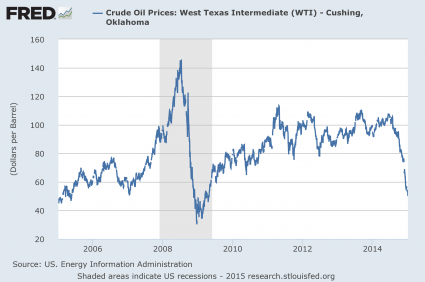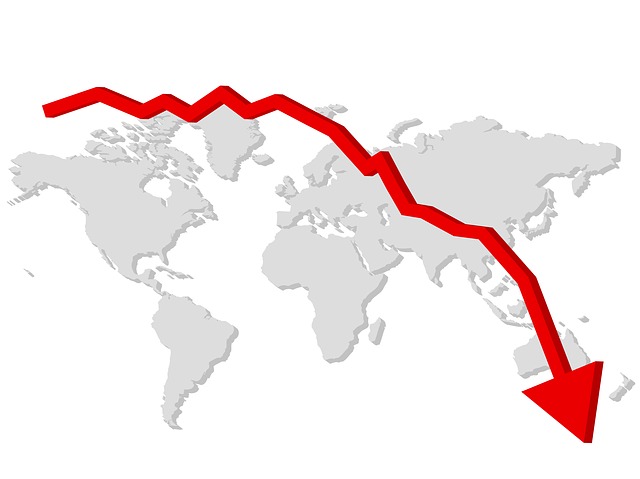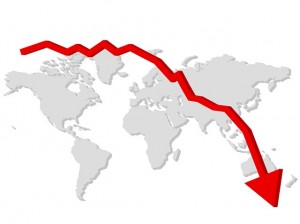 Are we on the verge of a major worldwide economic downturn? Well, if recent warnings from prominent bankers all over the world are to be believed, that may be precisely what we are facing in the months ahead. As you will read about below, the big banks are warning that the price of oil could soon drop as low as 20 dollars a barrel, that a Greek exit from the eurozone could push the EUR/USD down to 0.90, and that the global economy could shrink by more than 2 trillion dollars in 2015. Most of the time, very few people ever actually read the things that the big banks write for their clients. But in recent months, a lot of these bankers are issuing such ominous warnings that you would think that they have started to write for The Economic Collapse Blog. Of course we have seen this happen before. Just before the financial crisis of 2008, a lot of people at the big banks started to get spooked, and now we are beginning to see an atmosphere of fear spread on Wall Street once again. Nobody is quite sure what is going to happen next, but an increasing number of experts are starting to agree that it won’t be good.
Are we on the verge of a major worldwide economic downturn? Well, if recent warnings from prominent bankers all over the world are to be believed, that may be precisely what we are facing in the months ahead. As you will read about below, the big banks are warning that the price of oil could soon drop as low as 20 dollars a barrel, that a Greek exit from the eurozone could push the EUR/USD down to 0.90, and that the global economy could shrink by more than 2 trillion dollars in 2015. Most of the time, very few people ever actually read the things that the big banks write for their clients. But in recent months, a lot of these bankers are issuing such ominous warnings that you would think that they have started to write for The Economic Collapse Blog. Of course we have seen this happen before. Just before the financial crisis of 2008, a lot of people at the big banks started to get spooked, and now we are beginning to see an atmosphere of fear spread on Wall Street once again. Nobody is quite sure what is going to happen next, but an increasing number of experts are starting to agree that it won’t be good.
Let’s start with oil. Over the past couple of weeks, we have seen a nice rally for the price of oil. It has bounced back into the low 50s, which is still a catastrophically low level, but it has many hoping for a rebound to a range that will be healthy for the global economy.
Unfortunately, many of the experts at the big banks are now anticipating that the exact opposite will happen instead. For example, Citibank says that we could see the price of oil go as low as 20 dollars this year…
The recent rally in crude prices looks more like a head-fake than a sustainable turning point — The drop in US rig count, continuing cuts in upstream capex, the reading of technical charts, and investor short position-covering sustained the end-January 8.1% jump in Brent and 5.8% jump in WTI into the first week of February.
Short-term market factors are more bearish, pointing to more price pressure for the next couple of months and beyond — Not only is the market oversupplied, but the consequent inventory build looks likely to continue toward storage tank tops. As on-land storage fills and covers the carry of the monthly spreads at ~$0.75/bbl, the forward curve has to steepen to accommodate a monthly carry closer to $1.20, putting downward pressure on prompt prices. As floating storage reaches its limits, there should be downward price pressure to shut in production.
The oil market should bottom sometime between the end of Q1 and beginning of Q2 at a significantly lower price level in the $40 range — after which markets should start to balance, first with an end to inventory builds and later on with a period of sustained inventory draws. It’s impossible to call a bottom point, which could, as a result of oversupply and the economics of storage, fall well below $40 a barrel for WTI, perhaps as low as the $20 range for a while.
Even though rigs are shutting down at a pace that we have not seen since the last recession, overall global supply still significantly exceeds overall global demand. Barclays analyst Michael Cohen recently told CNBC that at this point the total amount of excess supply is still in the neighborhood of a million barrels per day…
“What we saw in the last couple weeks is rig count falling pretty precipitously by about 80 or 90 rigs per week, but we think there are more important things to be focused on and that rig count doesn’t tell the whole story.”
He expects to see some weakness going into the shoulder season for demand. In addition, there is an excess supply of about a million barrels of oil a day, he said.
And the truth is that many firms simply cannot afford to shut down their rigs. Many are leveraged to the hilt and are really struggling just to service their debt payments. They have to keep pumping so that they can have revenue to meet their financial obligations. The following comes directly from the Bank for International Settlements…
“Against this background of high debt, a fall in the price of oil weakens the balance sheets of producers and tightens credit conditions, potentially exacerbating the price drop as a result of sales of oil assets, for example, more production is sold forward,” BIS said.
“Second, in flow terms, a lower price of oil reduces cash flows and increases the risk of liquidity shortfalls in which firms are unable to meet interest payments. Debt service requirements may induce continued physical production of oil to maintain cash flows, delaying the reduction in supply in the market.”
In the end, a lot of these energy companies are going to go belly up if the price of oil does not rise significantly this year. And any financial institutions that are exposed to the debt of these companies or to energy derivatives will likely be in a great deal of distress as well.
Meanwhile, the overall global economy continues to slow down.
On Monday, we learned that the Baltic Dry Index has dropped to the lowest level ever. Not even during the darkest depths of the last recession did it drop this low.
And there are some at the big banks that are warning that this might just be the beginning. For instance, David Kostin of Goldman Sachs is projecting that sales growth for S&P 500 companies will be zero percent for all of 2015…
“Consensus now forecasts 0% S&P 500 sales growth in 2015 following a 5% cut in revenue forecasts since October. Low oil prices along with FX headwinds and pension charges have weighed on 4Q EPS results and expectations for 2015.”
Others are even more pessimistic than that. According to Bank of America, the global economy will actually shrink by 2.3 trillion dollars in 2015.
One thing that could greatly accelerate our economic problems is the crisis in Greece. If there is no compromise and a new Greek debt deal is not reached, there is a very real possibility that Greece could leave the eurozone.
If Greece does leave the eurozone, the continued existence of the monetary union will be thrown into doubt and the euro will utterly collapse.
Of course I am not the only one saying these things. Analysts at Morgan Stanley are even projecting that the EUR/USD could plummet to 0.90 if there is a “Grexit”…
The Greek Prime Minister has reaffirmed his government’s rejection of the country’s international bailout programme two days before an emergency meeting with the euro area’s finance ministers on Wednesday. His declaration suggested increasing minimum wages, restoring the income tax-free threshold and halting infrastructure privatisations. Should Greece stay firm on its current anti-bailout course and with the ECB not accepting Greek T-bills as collateral, the position of ex-Fed Chairman Greenspan will gain increasing credibility. He forecast the eurozone to break as private investors will withdraw from providing short-term funding to Greece. Greece leaving the currency union would convert the union into a club of fixed exchange rates, a type of ERM III, leading to further fragmentation. Greek Fin Min Varoufakis said the euro will collapse if Greece exits, calling Italian debt unsustainable. Markets may gain the impression that Greece may not opt for a compromise, instead opting for an all or nothing approach when negotiating on Wednesday. It seems the risk premium of Greece leaving EMU is rising. Our scenario analysis suggests a Greek exit taking EURUSD down to 0.90.
If that happens, we could see a massive implosion of the 26 trillion dollars in derivatives that are directly tied to the value of the euro.
We are moving into a time of great peril for global financial markets, and there are a whole host of signs that we are slowly heading into another major global economic crisis.
So don’t be fooled by all of the happy talk in the mainstream media. They did not see the last crisis coming either.











